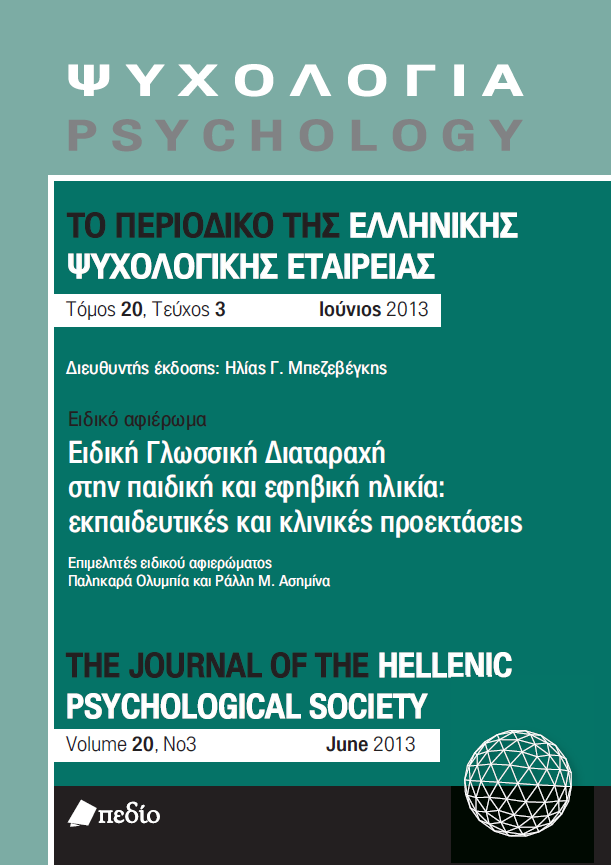Μελέτη της παραγωγής κλιτικών αντωνυμιών σε μονόγλωσσα και δίγλωσσα παιδιά με Ειδική Γλωσσική Διαταραχή

Περίληψη
Η αξιοποίηση της γλωσσικής επίδοσης παιδιών με Ειδική Γλωσσική Διαταραχή (ΕΓΔ) σε έργα ελέγχου παραγωγής κλιτικών αντωνυμιών ως κλινικού δείκτη της εν λόγω διαταραχής αποτελεί ένα από τα αμφιλεγόμενα διλήμματα του επιστημονικού πεδίου έρευνας του γλωσσικού προφίλ παιδιών με διάγνωση ΕΓΔ διαγλωσσικά. Αν και ευρήματα από μια σειρά διαγλωσσικών μελετών καταδεικνύουν ότι η παραγωγή κλιτικών αντωνυμιών είναι ιδιαίτερα προβληματική στην ΕΓΔ, μελέτες που διεξήχθησαν σε ελληνόφωνα παιδιά με ΕΓΔ δεν φαίνεται να συγκλίνουν ως προς τα αποτελέσματά τους. Πέντε ομάδες παιδιών, εκ των οποίων οι δύο με μονόγλωσσα και δίγλωσσα παιδιά με ΕΓΔ και οι υπόλοιπες με τυπικώς αναπτυσσόμενα παιδιά εξισωμένα ως προς τη χρονολογική ηλικία ή τη λεκτική ευφυΐα με τα παιδιά με ΕΓΔ, συμμετείχαν στην παρούσα έρευνα. Η μελέτη έθεσε υπό έλεγχο δύο γενικές υποθέσεις: (α) αν η δυσκολία των παιδιών με ΕΓΔ στην παραγωγή κλιτικών αντωνυμιών συνιστά χρονική καθυστέρηση στη γλωσσική ανάπτυξη ή έκφανση μιας ποιοτικά διακριτής ανα-
πτυξιακής πορείας στην ΕΓΔ, και (β) αν η διγλωσσία των παιδιών με ΕΓΔ θα λειτουργήσει αντισταθμιστικά στη γλωσσική τους δυσκολία. Τα αποτελέσματα έδειξαν ότι οι επιδόσεις των παιδιών με ΕΓΔ ήταν κατώτερες συγκριτικά των τυπικά αναπτυσσόμενων παιδιών ίδιας χρονολογικής ηλικίας, κατά συνέπεια συνηγορούν υπέρ της θεωρίας της χρονικής καθυστέρησης στην ΕΓΔ. Επίσης, η διγλωσσία των παιδιών με ΕΓΔ δε βρέθηκε να ασκεί σημαντική θετική αλλά ούτε και αρνητική επίδραση στις επιδόσεις των παιδιών.
Λεπτομέρειες άρθρου
- Πώς να δημιουργήσετε Αναφορές
-
Τσιμπλή Ι. .-. Μ., Περιστέρη Ε., & Ανδρέου Μ. (2020). Μελέτη της παραγωγής κλιτικών αντωνυμιών σε μονόγλωσσα και δίγλωσσα παιδιά με Ειδική Γλωσσική Διαταραχή. Ψυχολογία: το περιοδικό της Ελληνικής Ψυχολογικής Εταιρείας, 20(3), 302–320. https://doi.org/10.12681/psy_hps.23543
- Τεύχος
- Τόμ. 20 Αρ. 3 (2013)
- Ενότητα
- ΕΙΔΙΚΟ ΑΦΙΕΡΩΜΑ

Αυτή η εργασία είναι αδειοδοτημένη υπό το Creative Commons Attribution-ShareAlike 4.0 International License.
Το περιοδικό ΨΥΧΟΛΟΓΙΑ έχει υιοθετήσει μία πολιτική Platinum open-access. Τα έξοδα υποβολής, επεξεργασίας ή δημοσίευσης των εργασιών καλύπτονται από την Ελληνική Ψυχολογική Εταιρεία. Τα πνευματικά δικαιώματα των δημοσιευμένων εργασιών προστατεύονται από την άδεια 'Creative Commons Attribution-ShareAlike 4.0 International'. Οι Συγγραφείς διατηρούν τα Πνευματικά Δικαιώματα και χορηγούν στο περιοδικό το δικαίωμα της πρώτης δημοσίευσης. Η άδεια αυτή επιτρέπει σε τρίτους, να χρησιμοποιούν την εργασία σε οποιαδήποτε μορφή, με την προϋπόθεση της διατήρησης των διατυπώσεων που προβλέπονται στην άδεια σχετικά με την αναφορά στον αρχικό δημιουργό και την αρχική δημοσίευση στο περιοδικό ΨΥΧΟΛΟΓΙΑ. Επιπλέον, κάθε διανομή της εργασίας οφείλει να γίνεται με τους ίδιους όρους διανομής, δηλαδή με την ίδια άδεια Creative Commons.


